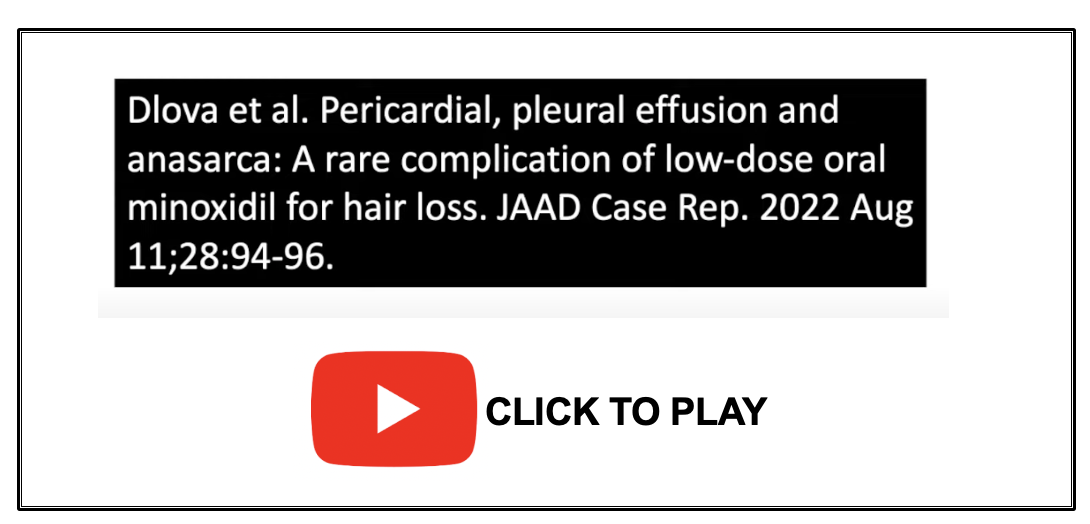Low dose Oral Minoxidil (LDOM): Fluid Retention can be Serious
Helpful Report Reminds us that Low Dose Oral Minoxidil is not Risk Free
Low dose oral minoxidil is increasingly used in the treatment of various types of hair loss. A variety of side effects are possible including hypertrichosis, headaches, shedding, fluid retention. The following diagram helps summarize some of the possible side effects.
Dlova et al 2022
Authors from South Africa presented a very nice report highlighting the possibility of significant fluid retention causing pericardial and pleural effusions in a healthy woman.
The authors report the case of an otherwise healthy 40 year old African woman with frontal fibrosing alopecia (FFA) who developed pericardial, pleural effusion and anasarca 3 weeks after LDOM therapy.
The patient’s FFA was treated with 5% topical minoxidil, tacrolimus ointment 0.1%, clobetasol propionate ointment, 100 mg of doxycycline twice daily, and 0.25 mg of oral minoxidil (OM) daily. This is considered an extremely low dose of oral minoxidil.
After 3 weeks of treatment, the patient developed swelling of both lower extremities and this spread to involve the upper extremities and also face. She was advised to stop oral minoxidil and present herself for follow-up, where she was admitted to the hospital for additional workup and further management.
Facial swelling in a patient using 0.25 mg of oral minoxidil. SOURCE: Dlova et al. Pericardial, pleural effusion and anasarca: A rare complication of low-dose oral minoxidil for hair loss. JAAD Case Rep . 2022 Aug 11;28:94-96. Used with creative commons license.
Cardiologists assessed the patient and identified generalized pitting edema involving the lower limbs, sacrum, and facial and periorbital areas as well as abdominal wall edema. The patient’s cardiovascular examination revealed a regular pulse of 85 beats/min. Her blood pressure was 110/ 70 mm Hg. The heart sounds were normal,
Ultrasound showed fluid collections in the pericardium, pleural space, and abdomen. An echocardiogram revealed a small pericardial effusion and no evidence of cardiac tamponade.
The patient was treated with 40 mg of intravenous furosemide daily for 4 days with potassium replacement. The patient’s edema resolved with diuretic treatment by day 4 of hospitalization and she was discharged. The edema resolved completely.
Conclusion and Discussion
This is a valuable study for all prescribers of low dose oral minoxidil. Contrary to popular opinion, low dose oral minoxidil comes with some risks. Fortunately the risks are not common - but we need to be prepared.
A review by Randolph and Tosti suggested that 3 % of patients receiving LDOM can have low limb edema. This seems to be most common in those receiving 5 mg doses. It is unusual for a patient to get such profound edema on 0.25 mg.
Edema is well known from the1970s and 1980s when oral minoxidil at 10-50 mg was used for hypertension. In those days, edema was well known and pericardial effusions occurred in 3 % of patients. It seemed that pericardial effusions were most common in those with kidney disease and those receiving dialysis but they could still occur in other patient groups.
This study reminds us that going slowly on low oral minoxidil doses is probably better than starting at high doses. Furthermore, it reminds us that patients with lower limb edema should be encouraged to stop and contact the office in order to determine the appropriate next step. This may help to prevent rapid progression to more severe involvement. Finally, the study reminds us that prescribing low dose oral minoxidil requires a good deal of patient counselling so that patient not only understand potential side effects but understand what to do if they get a particular side effect.
REFERENCE
Dlova et al. Pericardial, pleural effusion and anasarca: A rare complication of low-dose oral minoxidil for hair loss. JAAD Case Rep . 2022 Aug 11;28:94-96.
Randolph M, Tosti A. Oral minoxidil treatment for hair loss: a review of efficacy and safety. J Am Acad Dermatol. 2021;84(3): 737-746.
This article was written by Dr. Jeff Donovan, a Canadian and US board certified dermatologist specializing exclusively in hair loss.



